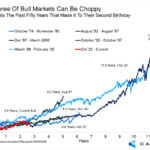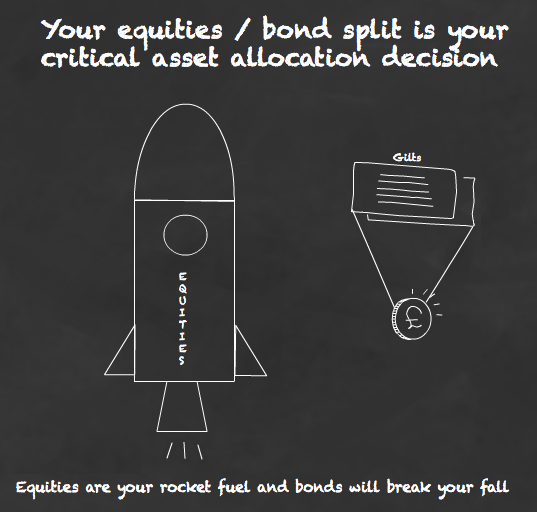Deciding upon your asset allocation can be as simple or as complicated as you wish to make it. You might watch a couple of TikTok videos and decide to go all-in on Griftcoin. Or spend the rest of your life drawing Bollinger bands on charts of obscure Japanese small caps.
A much better alternative is to:
- Learn the basic tenets of strategic asset allocation– that is, what blend of asset classes suits your circumstances and in what proportion?
- Understand what each of the main asset classes is for – how it behaves, the threats it combats, plus the risks and trade-offs you accept by holding it.
- Gain exposure via low-cost index trackers that deliver the performance of each asset class as faithfully as possible.
- Set-and-forget your portfolio, because it’s designed to cope with all investing weathers: rain, shine, inflation, deflation, stagflation, market crashes, and bursting bubbles.
In this post I’ll run you through a simple method to create a robust asset allocation. We’ll consider what questions to ask yourself along the way and some of the rules of thumb you can use to narrow down your answers.
But before that we need to do some spadework.
Asset allocation preparation
The first thing to understand is that there isn’t an optimal asset allocation.
Nobody knows in advance what the best performing assets will be over the next five, ten, or however many years.
That’s why the one consistent piece of advice you will hear is: Diversify.
Plenty of commentators make predictions. Forecasts are catnip for humans after all. Moreover, no one is ever seriously taken to task later for the accuracy of their calls. But it’s still notable that financial prognostications are bedecked with the kind of get-out clauses that would make a fortune-teller cover their face.
Forget the prediction game. It makes fools of us all.
In contrast, adopting a strategic asset allocation positions you for long-term success while offering protection against the many dangers that assail investors.
It’s all pros and cons
The second thing to know is that every asset class has its strengths and weaknesses.
Equities (also called stocks) are violently unpredictable, while nominal government bonds and cash are vulnerable to inflation.
Nothing is inherently ‘safe’.
However the mainstream assets we cover in this article can all play a role in a diversified portfolio.
Your task is to decide which mix is most likely to serve your personal goals.
Who’s portfolio is it, anyway?
Finally, it’s worth thinking hard about your particular objectives and risk profile.
Loud and influential figures on the Internet will speak of the astounding opportunities in Strategy X and the obvious inefficiencies of Strategy Y. But these confident voices rarely consider your age, financial situation, knowledge level, time constraints, or your baseline interest in the markets.
What’s sauce for them may be poison for you.
Compare a 60-something multi-millionaire retiree to a 20-something who’s scraping together £50 for their first ISA investment. These two are almost certainly not playing the same game nor speaking the same investment language.
So be careful who you listen to. Ask where they’re coming from.
Asset class action
To better understand which asset classes deserve a starring role in your portfolio it’s worth sketching out your plan in broad outline.
Think about:
- Investment goals – what’s the money for? Financial independence at 50? Retirement at 65? The rainiest of rainy days?
- In how many years will you need it?
- How much can you invest towards your goal?
An investment calculator can help you work out if your numbers add up.
The physics of investing mean that:
The amount you save…
Multiplied by your average investment return…
Over the years you invest…
Determines your future wealth.
If that amount falls short of your target number then you can decide to save more. Or invest for longer. Or to try to live on less.
By way of returns
Note though that your average investment return lies largely outside of your hands – which is something that many people find hard to accept.
Your portfolio’s expected return can stand in for your actual investment return when you first boot up your plan.
But your actual number achieved depends on unknowable future investment results.
You might attempt to nudge up the returns you achieve by increasing your allocation to a high-growth asset like equities.
But this is a risky move. Banking too much on such a volatile asset also increases the chance you’ll undershoot your target if stocks fail to deliver according to your timetable.
Fate is fickle.
Getting going
Alright, that’s enough planning background for now.
Don’t worry if your numbers are a little hazy. Think of investing as like piloting an old sailing ship in the days before GPS.
You just need a rough idea of where the land lies to begin with. You can always make further course corrections along the way.
Keeping it simple
The minimalist’s approach to portfolio diversification splits your money between equities and government bonds.
These two assets are a time-tested and complementary combo.
Equities are powerful like a rocket engine. When firing beautifully, they can shoot your wealth into the stratosphere. But this engine is prone to stalling. Occasionally equities will send your portfolio into a gut-wrenching free fall.
That’s why it’s wise to invest in government bonds, too. Firstly as an alternative (but lesser) source of thrust. Secondly because bonds often work when equities fail. This ‘flight-to-quality’ effect means bonds can cushion your portfolio during a stock market crash.
Historically, equities have outperformed all other mainstream asset classes – on average, if you can wait long enough for the market to come good.
And this tempts some people to go for glory with 100% stock portfolios.
But sometimes equities do suffer long losing streaks. You could spend a decade or more going nowhere.
That’s fine if you patiently keep buying shares on the cheap. History tells us they will rise again.
But problems rear when you can’t wait – because you’re a forced seller, or because you’re impatient, or because you panic when stocks bomb.
It’s easy to be swayed by the high average returns of equities. But you will rarely experience the average return.
Equities can be dreadful for years. Or they can be amazing for years, then suffer a terrible rout that wipes out all your progress.
Most likely, you’ll endure a wild ride that periodically flips from good to downright scary.
You probably shouldn’t give it 100%
These psychological switch backs are why people are generally ill-advised to go 100% equities.
Traditionally, such a high level of risk is more readily borne by:
- Beings with an emotional temperature near Absolute Zero.
- Someone who isn’t relying on the money.
- Investors who can easily repair the damage – typically because they are young and so have committed a negligible amount of their lifetime savings to the market so far.
In reality, few of us can happily stomach watching our wealth drop 50% to 90%. Many people don’t realise how awful it feels until it’s too late.
Hence, the trickiest part of asset allocation is understanding how much equity risk you can personally take.
Your place on the risk tolerance spectrum is impossible to know with any confidence until you’ve received your first shoeing in the market.
The finance industry uses risk profiling tests in an attempt to understand how you might react before then.
But we’ll offer an even cruder approach below.
Choosing your equities
Despite all the risks, most people must invest some of their portfolio in equities. That’s because their goals require a long-term rate of growth that they’re unlikely to get from bonds, cash, or the other asset classes.
Stocks’ inherent riskiness can be somewhat tempered by investing in the broadest pools of shares possible.
Spreading your money this way enables you to avoid taking concentrated bets on individual companies, industries, or regions that could hit the skids.
Global tracker funds enable passive investors to diversify away such idiosyncratic risks at a stroke. Moreover they enable you to invest in every important stock market in the world at the tap of a button for minimal cost.
Critically, the allocations of global index trackers are driven by the aggregate buy and sell decisions of every investor operating in these markets.
You’re harnessing the wisdom of the crowd when you invest this way.
Bring on the bonds
The point of bonds is to dilute the riskiness of equities. Hence we usually want to pair our shares with the least volatile bonds around:
- High-quality government bonds – ideally nominal short to intermediate durations, and/or short duration index-linked.
- From your home country – so gilts for UK investors. Or else global government bonds hedged to GBP.
What percentage of your portfolio should be devoted to bonds? Again, there’s no ‘correct’ answer. It depends on your personality, goals, and financial situation.
However we can throw a rope around your number using some general principles and rules of thumb.
Remember, we’re only investing in equities because we need the growth they offer over the long term. Whereas if you happen to own an orchard of money trees and wade through fallen bank notes like autumnal leaves then you won’t have to bother with all that nasty bear market business.
In such a scenario where you don’t need much growth – say just 0.5% to 1% real return per year over the next ten years – you can hugely reduce your reliance on equities.
In other words, if you’re more interested in capital preservation, then a bigger allocation to shorter-dated conventional government bonds and index-linked gilts makes sense.
Associated rule of thumb: 120 minus your age = your allocation to equities.
In particular if you need the money soon then equities are a big risk.
And by ‘soon’ I mean anytime in the next ten years.
Rushing roulette
Equities have a one-in-four chance of returning a loss inside any five-year period and a one-in-six chance of handing you a loss within a given ten years, according to Tim Hale in his superb book Smarter Investing.
So do not allocate anything like 100% to equities if you will need all of your money within that period.
Associated rule of thumb: Own 4% in equities for each year you’ll be investing. Put the rest of the portfolio in bonds.
If your target is flexible, or you can delay your plans, or the stock market money is a bonus in the big scheme of things for you, then you can increase the risk you take accordingly.
For example, if your retirement living expenses are amply covered by income streams such as a workplace pension and the State Pension then you could up your equity allocation in your ISAs, say.
If equities plunge in value then no matter. You can ride out the dip and enjoy the upside whenever a recovery comes.
That said, your risk tolerance is the house that rules all.
Risky business
The nightmare scenario with any asset allocation is that it’s too risky for you.
If you panic and sell when markets plunge you’ll lock in losses and permanently curtail your future returns.
Even young investors can be psychologically scarred by early losses that put them off investing for life.
But how do you know your risk tolerance until you’ve experienced a serious setback?
One solution for new investors is to dip only a cautious toe into the market to start with. For example, you could opt for a 50:50 equity-bond split until you’re tested by your first market crash.
Associated rule of thumb: Think about how much loss you could take. 50%? 25%? 10%? Write down the current value of your investments. Cross that figure out and replace with the amount it would be worth after enduring your loss.
Could you live with that if it took ten years to recover your original position? Limit your equity allocation to twice the percentage amount you can stand to lose.
William Bernstein, in his wonderful book The Investor’s Manifesto, provides handy instruction on how your personal risk tolerance might modify a rule of thumb such as ‘your age in bonds’:
| Risk tolerance | Adjustment to equities allocation | Reaction to last market crash |
| Very high | +20% | Bought and hoped for further declines |
| High | +10% | Bought |
| Moderate | 0% | Held steady |
| Low | -10% | Sold |
| Very low | -20% | Sold |
Bear in mind that your risk tolerance is a moving target. It’s known to weaken with age and as the amount at stake rises. Therefore even a seasoned investor should reassess their allocation from time to time and consider lifestyling to a lower equity allocation as they age.
Finally, remember that the rules of thumb aren’t scientifically calibrated. They’re quick and dirty shortcuts based upon the practical wisdom gathered by previous generations of financial practitioners and investors.
Hopefully they can guide you to the right destination at a relatively safe speed. But sadly there are no guarantees.
Here’s a final rule of thumb: a 60:40 equities and bonds split. This has become the industry standard for the ‘don’t know’ or ‘Joe Average’ investor.
Press play to continue
Once you’ve thought through your equity/bond division, you’ve made the asset allocation decision that will have the biggest impact upon your ultimate returns from investing.
The hard work is potentially over. If you like, you can now draw a line under the process and even outsource the fine details to one-stop, fund-of-funds like Vanguard’s LifeStrategy series
Keen to go further? Then you can carry on tweaking your asset allocation in search of further diversification.
Inflation defence
Equities, government bonds, and cash will take you a long way. But they do leave a chink in your armour.
All three assets typically flounder during long and hairy surges in inflation.
This doesn’t matter so much for young investors, who can rely on positive long-term growth rates from their shares to outstrip inflation eventually.
But retirees living off their portfolio should think about incorporating an inflation-resistant asset that they can sell as needed if consumer prices spiral.
Short-term, index-linked, government bond funds are likely to perform better than other bond funds in these circumstances. However, rapid interest rate rises proved an Achilles heel for these assets post-Covid.
Individual index-linked gilts (affectionately known as ‘linkers’) are a better match for fast-rising prices.
Linkers seem complicated at first, but mostly that’s because they’re unfamiliar rather than intrinsically complex.
If you’re an older investor who’s prepared to devote some time to learning about them then I think index-linked gilts are worth the effort.
Commodities also thrive during at least some inflationary episodes. And they can be bought off the shelf using diversified commodity ETFs.
Commodities also require a slog up a learning curve. You especially need to consider how extremely volatile commodities can be.
Still, the asset class’s long-term returns look reasonable – sitting between equities and bonds. We’ve put a 10% slug of commodities into our model retirement portfolio.
Gold is the final mainstream asset that periodically performs well against high inflation.
The yellow metal isn’t specifically designed to counter inflation like index-linked gilts are. Nor does gold have a reassuringly long track record of outstripping inflation like commodities.
But gold has worked during two of the last three price shocks.
Although gold’s recent performance makes it look like a no-brainer, the story is more nuanced over longer periods. Do make sure you understand the pros and cons of gold before making an allocation.
Further asset allocation ideas
There are plenty of other asset classes you could consider. We can debate them in the comments.
But the selection above covers the crucial assets. By themselves, they are enough to hit your goals and muster a porcupine defence against any of the major economic threats you’re likely to face.
One thing I haven’t mentioned is that many people have substituted money market funds for bonds since the latter crashed in 2022.
However, there are four reasons not to do this:
- The long-term returns of nominal government bonds are significantly higher than money market funds.
- Nominal government bonds are more likely to reduce stock market losses during a crash.
- Similarly, nominal govies are the place to be if deflation sets in.
- Lastly, government bonds are far better priced now than they were in 2022.
Reasons two and three also explain why you’d hold a nominal government bond allocation that’s separate from a slug of index-linked bonds.
How much?
Know that it’s absolutely fine to carve out your allocations in big 5-10% blocks. The odd fiddly percentage point here and there will make little difference to your final score.
Most people should avoid adding so many sub-asset classes that you end up with a raft of sub-5% allocations.
These add unnecessary complexity for negligible gain.
Model behaviour
Okay, I know that’s a lot to take in. No wonder many investors turn to model portfolios to help firm up their ideas.
Some ready-to-share asset allocations we’ve written up include:
However you go, you’ll find there’s a good range of low-cost index trackers to cover almost all the asset classes you might include in your portfolio.
Take it steady,
The Accumulator
Note: we updated a decade-old article on asset allocation to create this post, so early comments below may refer to this previous incarnation. We like to keep our old discussions for posterity, but please do check the dates with anything time sensitive.








